A Rags to Rich-S Story Of course, "Rags to Riches” is a catch phrase for the great American success stories. At Pigeon River Farm, we have our own version of this classic story. We started with 50 acres of Rag-weed, and we turned it into Rich Soil. Our Rich Soil is the foundation for Pigeon River Farm's wholesome, incredibly flavorful and nutritious family farm products for your table. 2003 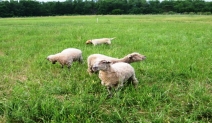 In July 2003 a family member informed us about some farm-land for sale in Northern Waupaca County, WI. We were told that this land had not been farmed for a year and a half. When we went to look at the land there was no question it had not been farmed for a while. What we found was a field of Ragweed as far as the eye could see. This was just what we needed if we wanted to build an organic farm - land that had been untouched for some time. After much discussion and knowledge from friends who knew about the organic process, we decided we would put in an offer. In October we bought the 50-acre property. In July 2003 a family member informed us about some farm-land for sale in Northern Waupaca County, WI. We were told that this land had not been farmed for a year and a half. When we went to look at the land there was no question it had not been farmed for a while. What we found was a field of Ragweed as far as the eye could see. This was just what we needed if we wanted to build an organic farm - land that had been untouched for some time. After much discussion and knowledge from friends who knew about the organic process, we decided we would put in an offer. In October we bought the 50-acre property.
2004 The following year, the real work began. We were (and still are) using six tractors, plus dozens of implements. We chose smaller equipment to 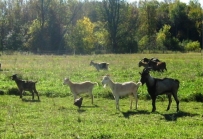 minimize compaction problems. Farmall A, Farmall H, 2 Farmall M, Farmall 450, and IH 766. Many of the implements we are using are the ones used years ago. They have served us well. minimize compaction problems. Farmall A, Farmall H, 2 Farmall M, Farmall 450, and IH 766. Many of the implements we are using are the ones used years ago. They have served us well. 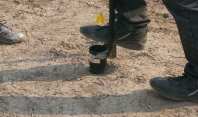 In 2004 we worked up twenty acres and planted barley and sorghum as a cover crop. As it grew, it was chopped back in to help give nutrients to the soil. After the last cutting we left it in over the winter to prevent soil erosion from the winds. The soil is prepared for planting our Hazelnuts which were also ready to plant. String was strung out for the rows of Hazelnut and Chestnut trees. Planting of the seedlings was done by using a large bulb digger. Watering was done by hand. This was our first attempt at irrigation. Later we started using a much more efficient and effective drip system. In 2004 we worked up twenty acres and planted barley and sorghum as a cover crop. As it grew, it was chopped back in to help give nutrients to the soil. After the last cutting we left it in over the winter to prevent soil erosion from the winds. The soil is prepared for planting our Hazelnuts which were also ready to plant. String was strung out for the rows of Hazelnut and Chestnut trees. Planting of the seedlings was done by using a large bulb digger. Watering was done by hand. This was our first attempt at irrigation. Later we started using a much more efficient and effective drip system.
2005 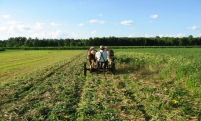 The following spring we began working up the soil from the previous fall. Soon it would be planting time. We continued working up some sections that needed a little more TLC, and soon the Barley started coming up. The following spring we began working up the soil from the previous fall. Soon it would be planting time. We continued working up some sections that needed a little more TLC, and soon the Barley started coming up.
Using our Farmall A with a Cultivator, we began cultivating another field which had been worked up the previous year. 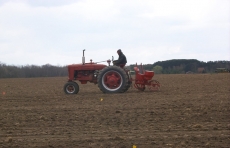 We then planted Alfalfa with a Barley cover. We planted corn in-between the Hazelnut and Chestnut trees. This was planted as a wind breaker for the seedlings. We also planted an additional five acres of corn. We then began working up a new field that had a cover crop of winter wheat from 2004. We worked it wth a cultivator with added green manure to help feed the soil and assist in weed control. We then planted Alfalfa with a Barley cover. We planted corn in-between the Hazelnut and Chestnut trees. This was planted as a wind breaker for the seedlings. We also planted an additional five acres of corn. We then began working up a new field that had a cover crop of winter wheat from 2004. We worked it wth a cultivator with added green manure to help feed the soil and assist in weed control.
Our first chopping of Barley was put back into the field as green manure. We then moved on to harvesting the Winter Wheat. Later that fall we did our second planting of Hazelnut and Chestnut trees. 2006 During the winter months it is time to do maintenance and prepare tractors and implements for spring. Come spring, it is time to prepare fields by disking and rotor-tilling. Then the planting begins. Weed control is very important early on. We use a rotary hoe which knocks the weeds back. Mid June it's time for the first cutting of hay. When that is finished, it is time to start shucking last years corn. End of June it is time to start combining winter wheat. Also it's time to cut the second crop of hay. When all that is done, we start plowing for winter wheat stubble. End of November and time to get ready to cut the corn down! 2007 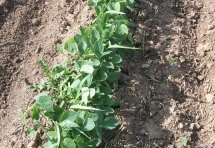 In April we prepared a Field which had been planted in corn the previous year. The ground was worked up by plowing and then using a rotary hoe and drag. This year we are planting the field in alfalfa. In April we prepared a Field which had been planted in corn the previous year. The ground was worked up by plowing and then using a rotary hoe and drag. This year we are planting the field in alfalfa.
In May we tilled up between the rows of Hazelnut trees and planted the area with soybeans. Early June it was time to cultivate the corn, as the weeds were beginning to show themselves. By mid-June the soybeans were coming up nicely. In early July we green chopped some of the alfalfa to be used for mulch around the Hazelnut trees. In July the alfalfa was cut and baled. We also had cow manure brought in and spread in one area where we would leave it sit for two years before it was used. In October we started working up a new field. Later that month we used a rotary hoe and drag on a newly worked up field. We were also transporting equipment up to our farm from our place in Kenosha, Wisconsin. We also started cutting the corn we had planted that year. Then it was time to start working up another new field. Come November, the soybeans had been cut and it was time to work up the field. It is now December and time to start working on tractors and upgrading by installing a 3-point hitch and other accessories. 2008 When the tractors are not working in the field, they are moving snow. After the snow is put into piles, it is time to have some fun! 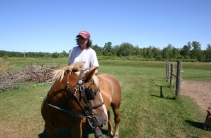 In May we installed a 3-point hitch on our Allis Chalmers. We also started spreading aged manure around our Hazelnut trees. In May we installed a 3-point hitch on our Allis Chalmers. We also started spreading aged manure around our Hazelnut trees.
The alfalfa and winter wheat were doing great. In August we purchased our newest family member, her name is Candy. She is a Halflinger horse. She was raised by a good Amish friend and neighbor. She is very gentle and hard working. It was also time to bale the third hay cutting. |